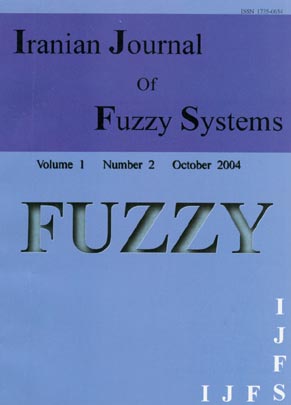فهرست مطالب

Iranian journal of fuzzy systems
Volume:1 Issue: 2, 2004
- 87 صفحه،
- تاریخ انتشار: 1383/07/15
- تعداد عناوین: 5
-
-
Page 1In this paper, a new Fuzzy Morphology (FM) based on the Generalized Dempster Shafer Theory (GDST) is proposed. At first, in order to clarify the similarity of definitions between Mathematical Morphology (MM) and Dempster Shafer Theory (DST), dilation and erosion morphological operations are studied from a different viewpoint. Then, based on this similarity, a FM based on the GDST is proposed. Unlike previous FM’s, proposed FM does not need any threshold to obtain final eroded or dilated set/image. The dilation and erosion operations are carried out independently but complementarily. The GDST based FM results in various eroded and dilated images in consecutive alpha-cuts, making a nested set of convex images, where each dilated image at a larger alpha-cut is a subset of the dilated image at a smaller alpha-cut. Dual statement applies to eroded images.
-
Page 15The i.p.s hypergroups were investigated in [1], [2], [3], [4] and it was proved that if the order is less than 9, they are strongly canonical (see [13]). In this paper we have found the sequences of fuzzy sets and of join spaces determined (see [8]) by all i.p.s. hypergroups of order seven. For the meaning of the hypergroups iH and the notations, see [7], [8].
-
Page 33In this paper at first we show that the cosets of a fuzzy ideal $\mu$ in a BCK–algebra $X$ form another BCK–algebra $frac{\mu}{X}$ called the fuzzy quotient BCK–algebra of X by $\mu$. Also we show that $frac{\mu}{X}$ is a fuzzy partition of $X$, and some isomorphism theorems are proved. Moreover we prove that, if the associated fuzzy similarity relation of a fuzzy partition $P$ of a commutative BCK–algebra is compatible, then $P$ is a fuzzy quotient BCK–algebra. Finally the notion of a coset of a fuzzy ideal and an element of a BCK-algebra is defined and some related theorems are proved.
-
Page 45Pedomodels have become a popular topic in soil science and environmental research. They are predictive functions of certain soil properties based on other easily or cheaply measured properties. The common method for fitting pedomodels is to use classical regression analysis, based on the assumptions of data crispness and deterministic relations among variables. In modeling natural systems such as soil system, in which the above assumptions are not held true, prediction is influential and we must therefore attempt to analyze the behavior and structure of such systems more realistically. In this paper we consider fuzzy least squares regression as a means of fitting pedomodels. The theoretical and practical considerations are illustrated by developing some examples of real pedomodels.
-
Page 63In this note first we define the notions of fuzzy positive implicative hyper BCK-ideals of types 1,2,3 and 4. Then we prove some theorems which characterize the above notions according to the level subsets. Also we obtain the relationships among these notions, fuzzy (strong, weak, reflexive) hyper BCK-ideals and fuzzy positive implicative hyper BCK-ideals of types 5,6,7 and 8. Then, we define the notions of fuzzy (weak) implicative hyper BCK-ideals and we obtain some related results. Finally, by considering the product of two hyper BCK-algebras we give some theorems which show that how the projections of a fuzzy (positive implicative, implicative) hyper BCK-ideal is again a fuzzy (positive implicative, implicative) hyper BCK-ideal.

